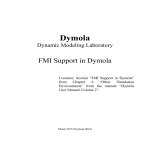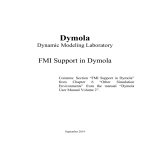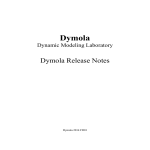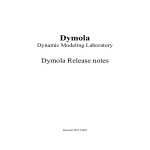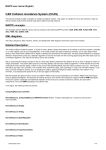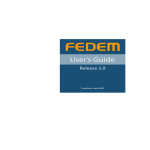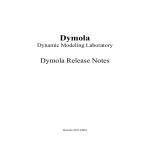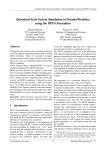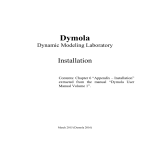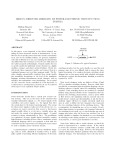Download MATLAB TARGET SUPPORT PACKAGE - RELEASE NOTES User manual
Transcript
Dymola
Dynamic Modeling Laboratory
Dymola Release Notes
Dymola 2015
The information in this document is subject to change without notice.
Document version: 1
© Copyright 1992-2014 by Dassault Systèmes AB. All rights reserved.
Dymola® is a registered trademark of Dassault Systèmes AB.
Modelica® is a registered trademark of the Modelica Association.
Other product or brand names are trademarks or registered trademarks of their respective holders.
Dassault Systèmes AB
Ideon Science Park
SE-223 70 Lund
Sweden
Support:
URL:
Phone:
http://www.3ds.com/support
http://www.Dymola.com
+46 46 2862500
Contents
1
2
3
Important notes on Dymola .................................................................................................... 5
About this booklet ................................................................................................................... 5
Dymola 2015 ............................................................................................................................. 6
3.1 Introduction ...................................................................................................................................................... 6
3.1.1
Additions and improvements in Dymola ................................................................................................ 6
3.1.2
New and updated libraries ...................................................................................................................... 7
3.1.3
Limited Availability Features ................................................................................................................. 7
3.2 Developing a model ......................................................................................................................................... 8
3.2.1
Modelica Standard Library version 3.2 not included .............................................................................. 8
3.2.2
Improved declaration of variables .......................................................................................................... 8
3.2.3
The Split Model command enhanced and improved ............................................................................ 10
3.2.4
Diagram layer zooming by spanning a rectangle .................................................................................. 11
3.2.5
Selected commands (built-in functions) available as a library ............................................................. 12
3.2.6
Improved handling of tables ................................................................................................................. 13
3.2.7
Print preview available ......................................................................................................................... 13
3.2.8
On-demand loading of models and packages (LA) .............................................................................. 14
3.2.9
Minor improvements ............................................................................................................................ 15
3.3 Simulating a model ........................................................................................................................................ 16
3.3.1
Print preview available ......................................................................................................................... 16
3.3.2
Plot window .......................................................................................................................................... 16
3.3.3
Scripting ............................................................................................................................................... 17
3.3.4
Minor improvements ............................................................................................................................ 18
3.4 Installation ...................................................................................................................................................... 21
3.4.1
Installation on Windows ....................................................................................................................... 21
3.4.2
Installation on Linux ............................................................................................................................. 21
3.5 Model Management ....................................................................................................................................... 22
3.5.1
Extended encryption of libraries ........................................................................................................... 22
3.6 Other Simulation Environments ..................................................................................................................... 22
3.6.1
Dymola – Matlab interface ................................................................................................................... 22
3.6.2
Real-time simulation............................................................................................................................. 23
3.6.3
New Java interface for Dymola on Windows ....................................................................................... 24
3.6.4
Python interface for Dymola on Windows available ............................................................................ 24
3.6.5
FMI Support in Dymola ....................................................................................................................... 25
3.6.6
Code and Model Export ........................................................................................................................ 34
3
3.7 Advanced Modelica Support .......................................................................................................................... 34
3.7.1
Minor improvements ............................................................................................................................ 34
3.8 New libraries .................................................................................................................................................. 34
3.8.1
Flight Dynamics Library ...................................................................................................................... 34
3.9 Updated libraries ............................................................................................................................................ 36
3.9.1
Air Conditioning Library ...................................................................................................................... 36
3.9.2
DataFiles Library .................................................................................................................................. 36
3.9.3
Design Library ...................................................................................................................................... 36
3.9.4
Electric Power Library.......................................................................................................................... 36
3.9.5
Engine Dynamics Library ..................................................................................................................... 36
3.9.6
Fuel Cell Library .................................................................................................................................. 36
3.9.7
Heat Exchanger Library........................................................................................................................ 36
3.9.8
Hydraulics Library ................................................................................................................................ 37
3.9.9
Hydro Power Library ............................................................................................................................ 38
3.9.10
Liquid Cooling Library ......................................................................................................................... 38
3.9.11
Model Management Library ................................................................................................................. 38
3.9.12
Plot 3D Library ..................................................................................................................................... 38
3.9.13
Pneumatics Library ............................................................................................................................... 38
3.9.14
Thermal Power Library ........................................................................................................................ 38
3.9.15
User Interaction Library ....................................................................................................................... 38
3.9.16
Vapor Cycle Library ............................................................................................................................. 39
3.9.17
Vehicle Dynamics Library.................................................................................................................... 39
3.10
Documentation .......................................................................................................................................... 40
3.11
Appendix – Installation: Hardware and Software Requirements .............................................................. 41
3.11.1
Hardware requirements/recommendations ........................................................................................... 41
3.11.2
Software requirements .......................................................................................................................... 41
4
1
Important notes on Dymola
Installation on Windows
To translate models on Windows, you must also install a supported compiler. The compiler
is not distributed with Dymola.
Note that administrator privileges are required for installation.
Two types of compilers are supported on Windows in Dymola 2015:
Microsoft Visual Studio C++
This is the recommended compiler for professional users.
Note that free Microsoft compiler versions earlier than Microsoft Visual Studio Express
2008 are not supported (concerning full versions, some earlier versions are supported).
Refer to section “Compilers” on page 41 for more information.
GCC
Dymola 2015 introduces limited support for the MinGW GCC compiler. For the list of
current limitations; refer to section “GCC compiler supported” on page 21.
Installation on Linux
To translate models, Linux relies on a GCC compiler, which is usually part of the Linux
distribution. Refer to section “Dymola versions on Linux and operating system versions, and
compiler” on page 42 for more information.
2
About this booklet
This booklet covers Dymola 2015.
The disposition is similar to the one in Dymola User Manual Volume 1 and 2; the same
main headings are being used (except for, e.g., Libraries and Documentation).
Dymola 2015 Release Notes
5
3
3.1
Dymola 2015
Introduction
3.1.1 Additions and improvements in Dymola
A number of improvements and additions have been implemented in Dymola 2015. In
particular, Dymola 2015 provides:
• Extended FMI support:
o Support of FMI 2.0 Release Candidate 1 (page 25).
o All Dymola solvers supported for FMU Co-Simulation export for FMI 1.0
on Windows (page 25).
o Improved handling of external resources for FMU export on Windows
(page 26)
o String parameters are supported (page 28).
o Online tunable parameters supported for FMI 2.0 RC1 (page 30).
o Structured declaration of variables supported for FMI 2.0 RC1 (page 30).
o Improved import of FMUs with many inputs/outputs (page 31).
• New interfaces to Dymola on Windows:
o Java (page 24)
o Python (page 24)
• Model creation by copying, using the Split Model command, is now supported (page
10).
• Simplified zooming in the diagram layer (page 11).
• Extended plot support:
o User-defined time units (page 16).
o Headers defined as text objects (font etc. can be changed) (page 16).
• New compiler on Windows: GCC (limited support) (page 21).
• Improved declaration of variables (page 8).
• Improved handling of tables (page 13).
• Improved robustness of license borrowing for Windows: FLEXnet license server
upgraded (page 21).
• Selected commands (built-in functions) available as a library (page 8).
• Print preview available (page 13).
• Extended encryption of libraries to faster find the correct version of the libraries (page
22).
• On-demand loading of models and packages (Limited Availability) (page 14).
6
3.1.2 New and updated libraries
New libraries
The following libraries are new:
• Flight Dynamics Library, version 1.0.
For more information about the new libraries, please see section “New libraries” starting on
page 34.
Updated libraries
The following libraries have been updated:
• Air Conditioning Library, version 1.8.7.
• DataFiles Library, version 1.0.1.
• Design Library, version 1.0.3.
• Electric Power Library, version 2.1.1.
• Engine Dynamics Library, version 1.2.1.
• Fuel Cell Library, version 1.2.1.
• Heat Exchanger Library, version 1.1.
• Hydraulics Library, version 4.0.
• Hydro Power Library, version 2.4.
• Liquid Cooling Library, version 1.2.1.
• Model Management Library, version 1.1.2.
• Plot 3D Library, version 1.0.3.
• Pneumatics Library, version 1.6.2.
• Thermal Power Library, version 1.8.
• User Interaction Library, version 0.63.
• Vapor Cycle Library, version 1.1.
• Vehicle Dynamics Library, version 1.9.
For more information about the updated libraries, please see the section “Updated libraries”
starting on page 36.
3.1.3 Limited Availability Features
This version of Dymola contains certain features which are labeled “Limited Availability”
(LA). It means that the implementation might be partial, diagnostics partial, the testing is
not complete, and no support/maintenance and only limited documentation is available.
However, we provide them to you as early as possible in order for you learn about these
features, plan for later use, and be able to give us your feedback. You typically need to set
some switch to enable them. These features are planned to become Generally Available
(GA) in the Dymola 2015 FD01 release.
Dymola 2015 Release Notes
7
The LA features are briefly described below and are marked (LA). In this release the ondemand loading of models and packages is the only main LA feature.
3.2
Developing a model
3.2.1 Modelica Standard Library version 3.2 not
included
In Dymola 2015 only Modelica Standard Library version 3.2.1 is included in the
distribution, and Modelica Standard Library 2.2.2 (for compatibility reasons).
3.2.2 Improved declaration of variables
Type selection in variable declaration dialog improved
When declaring or editing a variable, it is now possible to select types other than Real,
Integer, Boolean, and String; a new button Select Type in the dialog enables searching and
inserting from all types available in the package browser (like the present Insert Type
command).
The selected type will be added to the dropdown type list as selected:
8
To see the whole type without using the dropdown menu, make the window wider.
Variable declaration added to the Modelica Text layer context menu
The context menu in the Modelica Text layer has been extended to allow defining new
variables:
Selecting this command displays the variable declaration dialog. The new variable is added
at the end of the declaration part of the Modelica Text layer. (The command Edit > Insert
Variable works the same.)
Dymola 2015 Release Notes
9
A new variable declaration can only be added if there are no syntax errors in the Modelica
text.
3.2.3 The Split Model command enhanced and
improved
Model creation by copying, using the Split Model command, is now
supported
A new selection Copy to model is available when using the split model command. (The
command is reached by right-clicking on selected objects and selecting Split Model…, or by
Edit > Split Model…)
The selected objects will be copied to a new model.
General improvements
In addition to the above, the Split Model command has been improved in general:
• For all options (Create submodel, Move to base class, and Copy to model),
parameters used in the components are copied to the sub-system for more cases.
Previously they were only copied when the parameters or components of them were used
(“=p” and “=p.x”). Now this has been extended; parameters are now also copied when
used in arrays/matrices/simple arithmetic expressions.
• For all options (Create submodel, Move to base class, and Copy to model),
inner/outer components are now also copied to the sub-system. This is similar to
parameter handling. However, the alternative Create submodel if necessary changes
inner/outer components to outer components, without any modifiers, in order to create
an appropriate submodel.
10
3.2.4 Diagram layer zooming by spanning a rectangle
The diagram layer (and the icon layer) can now be zoomed by pressing Alt and spanning a
rectangle 1.
Releasing the mouse, the result is:
1
On Linux, Ctrl+Shift have to be used instead of Alt.
Dymola 2015 Release Notes
11
To go back (to default), set the zoom to 100% in the dropdown menu in the upper toolbar, or
use the new command Fit to Window in the context menu of the diagram layer or icon layer.
3.2.5 Selected commands (built-in functions) available
as a library
Previous version of Dymola introduced a package with selected commands (built-in
functions). This package is now available as a library in the library menu. The library can be
opened by the command File > Libraries > DymolaCommands.
12
3.2.6 Improved handling of tables
When tables are large (more than 10000 cells), the default functionality in the matrix editor
is now only to import/export and plot them, not to edit them. If editing is to be done, a
command must be given; a warning that this will be a time-consuming operation follows.
This improves handling of large tables, since many users are content with import/export and
plot.
3.2.7 Print preview available
In Dymola 2015, the command File > Print Preview displays a print preview, where for
example the effect of selecting portrait or landscape printing can be displayed. The print
setup can be changed, and printing can be done from the window.
Dymola 2015 Release Notes
13
3.2.8 On-demand loading of models and packages (LA)
It
is
possible
to
select
to
avoid
loading
classes
using
Advanced.DemandLoadClasses. The following alternatives are available:
Advanced.DemandLoadClasses = 0;
This is the default value; entire libraries are loaded in Dymola when needed.
14
the
flag
Advanced.DemandLoadClasses = 1;
Classes in libraries are loaded when needed. Classes are needed when they are used for
components/base-classes in the GUI, or used during translation. Note that Parameter dialogs
with class-selectors will usually load complete libraries when using this setting. The end
result of this setting is the same as the default setting, but the loading of classes rather than
whole libraries speeds up the start-up time of opening a large model in Dymola.
Advanced.DemandLoadClasses = 2;
Classes in libraries are only loaded when needed, even if that reduces the choices in the
GUI; e.g. the class-selectors that include the matching classes will not load new classes.
This setting further speeds up the start-up time of opening a large model in Dymola.
There are some restrictions for on-demand loading:
•
•
•
Older libraries without the file package.order in each directory will be read
completely.
Encrypted libraries are read completely.
In the Demo version of Dymola the libraries included with Dymola will be read
completely.
3.2.9 Minor improvements
Improved handling of array elements
In Dymola 2015 all array variable elements can be set individually (value, start, quantity,
min, max, nominal, stateSelect, fixed, unit, displayUnit). Previously only value, start and
quantity were supported to set individually.
Code completion in the Modelica Text editor for incomplete models
The code completion in the Modelica Text editor now also works for Modelica texts that
have syntactic errors. Thus you can add a declaration of a new component and the code
completion will give you its subcomponents, even if the declaration of the component is not
yet syntactically correct.
Improved handling of adjustable maximum line length in the Modelica
Text editor
The dotted vertical line in a Modelica Text editor that indicates the maximum line length is
now local for each Modelica Text editor window. (The line can be dragged to change the
maximum line length, the user can then adapt to the new value by right-clicking and
selecting the command Highlight Syntax, or by giving the corresponding short command
Ctrl+L).
Improved support for checking of interactive functions
If a function calls a built-in function that is not defined in the Modelica Language
Specification (such as translateModel) a check will no longer state that
Dymola 2015 Release Notes
15
translateModel is an unknown function – a warning will instead recommend using the
following annotation to turn off the warning:
annotation(__Dymola_interactive=true);
Both with and without that annotation the check will be less thorough than for normal
functions; but performs some checks, e.g. the spelling of function names.
Displaying of constants in the Used Classes layer now controllable
Right-clicking in the Used Classes layer of the Edit window, and selecting Settings, a new
entry Include Constants is available. Constants are by default displayed.
3.3
Simulating a model
3.3.1 Print preview available
In Dymola 2015, the command File > Print Preview displays a print preview. See page 13.
3.3.2 Plot window
User-defined time units supported
The selections available for the time on the horizontal axis are now the same as the userdefined time units, except s (seconds) that is always shown as default time unit.
(User-defined time units are the display units for time.)
16
Plot headings treated as text objects
In Dymola 2015 plot headings are treated as text objects; font size, alignment, color, etc. can
be changed by the menu that appears when double-clicking the header or right-clicking the
header and selecting Edit Text….
The header can be deleted using the context menu of the header.
The functionality is also supported by scripting, using the new built-in function
plotHeading. The header above can be created, using this function, as:
plotHeading(textString="Coupled Clutches\nw plots",
fontSize=12, lineColor={0,0,255}, textStyle={TextStyle.Bold,
TextStyle.Italic});
3.3.3 Scripting
New command for clearing all flags
A new built-in function clearFlags has been added; executing this function resets all flags
and integer constants to their default values.
Dymola 2015 Release Notes
17
New command for multi-simulation
A new built-in function has been added: simulateMultiResultsModel. The function is
similar to the existing built-in function simulateMultiExtendedModel; the difference is
that the result of using the existing one gives the endpoints, while the result of the new
function is the whole trajectories.
An example of call is:
simulateMultiResultsModel(
"Modelica.Mechanics.Rotational.Examples.CoupledClutches",
stopTime=1.2, numberOfIntervals=10, resultFile="CoupleCluches",
initialNames={"freqHz"}, initialValues=[0.1;0.2;0.3;0.4],
resultNames={"J1.w","J3.w"});
A comparison between the now available built-in functions for simulation:
Function
simulateModel
Additional input
simulateExtendedModel
Parameter values and start
values (for one simulation).
As simulateExtended model,
but for several simulations.
As simulateExtended model,
but for several simulations.
simulateMultiExtendedModel
simulateMultiResultsModel
Output
Trajectories for one
simulation.
Endpoints for one
simulation.
Endpoints for several
simulations.
Trajectories for several
simulations.
3.3.4 Minor improvements
Improving the code efficiency when using the Visual Studio 2012
compiler
The Visual Studio 2012 compiler is fully supported. However, this compiler by default
generates a bit less efficient code than previous versions of the compiler, with the selected
optimization settings. As a temporary work-around you can set the flag
Advanced.Define.GlobalOptimizations = 2;
before generating code, to activate global optimization in the compiler. (The default value of
the flag is 0.)
This flag works the same for all Visual Studio compilers, but the effect on compilers of
previous versions is small. For the Visual Studio 2012 compiler, however, the simulation
performance is restored, but the compilation of the code might take substantially longer for
large models.
The setting above corresponds to the compiler command /Og.
18
Simulation status indicated in Variable browser
The simulation status (Running, Failed, and Stopped) of the simulation result files is
indicated in the Variable browser. Failed and Stopped are indicated by a warning icon
in
front of the result file name, while Running is indicated by the text (Running) after the
result file name. No text means that the simulation is finished with success.
Result files of failed and stopped simulations can also be kept, but that is not indicated by
any pin symbol. To see the complete status for a result file, use the tooltip.
Changed default value of the parameter Erase in plotArray and
plotParametricCurve
The default value of the parameter erase is now true for the built-in functions
plotArray and plotParametricCurve. This means that old plots are erased when new
plots are created, if this default value is used.
Changed type for some input parameters in some built-in plot functions
Some input parameters in some built-in plot functions have changed type; from Integer to
Enumeration.
Built-in function
Input parameters with type
change to enumeration
createPlot
patterns
markers
patterns
markers
patterns
markers
patterns
markers
plot
plotArrays
printPlot
Dymola 2015 Release Notes
19
printPlotArrays
plotSignalOperator
plotSignalOperatorHarmonic
plotText
patterns
markers
signalOperator
signalOperator
window
lineStyle
horizontalAlignment
Session setting for erasing plots when loading new file after simulation
A new flag Advanced.DefaultAutoErase can be used to set, for the session, if plots
should be erased or not when loading a new file after simulation. The default value is true,
meaning that the plots are erased when loading a new file after simulation.
The value of the flag only influences plot windows created by GUI commands. Plot
windows created by the built-in function createPlot follow the input argument
autoerase of the function.
The setting Erase plot when loading new file after simulation in the plot window now
only influences the current plot window. This setting is available in the Options tab of the
plot setup, reached by the command Plot > Setup… (or by right-clicking in the plot, then
selecting Setup…).
Alphabetical order output and wildcards support in some built-in
functions
The output from the built-in functions list() and variables() are now in alphabetical
order, and grouped.
The wildcards* and ? are supported when using them, for example:
•
•
list(variables={"A*"}) – lists all items starting with A.
list(variables={"Advanced.*"}) – lists all items starting with Advanced. – that
is, list all Advanced flags settings.
•
20
list(variables={"*Output*"}) – lists all items containing Output in the text.
3.4
Installation
For the current list of hardware and software requirements, please see chapter “Appendix –
Installation: Hardware and Software Requirements” starting on page 41.
3.4.1 Installation on Windows
GCC compiler supported
Dymola 2015 introduces limited support for the MinGW GCC compiler. The compiler is
selected by using the simulation setup, reached for example by the command Simulation >
Setup…, the Compiler tab.
In order to use the GCC compiler, the user must download and install MinGW, with a GCC
version compatible with 4.8.
Limitations
• Only ordinary simulation is supported (no DLL, FMU Export, DDE or OPC servers).
• Only 32-bit simulation is supported.
• Commercial libraries: Only limited testing, no support for external library resources.
• No support for run-time license.
Upgraded FLEXnet license server
The Dymola program and the vendor daemon have been upgraded to version 11.11 of
FLEXnet on Windows.
3.4.2 Installation on Linux
Dymola on Linux now runs on SUSE Linux (Release 11), 32-bit and 64-bit, with gcc
version 4.3.4, and compatible systems. In addition to gcc, the model C code generated by
Dymola 2015 Release Notes
21
Dymola can also be compiled by clang. To change compiler, change the variable CC in
/opt/Dymola/insert/dsbuild.sh.
64-bit support on Linux
For information related to the 64-bit Linux version of Dymola 2015 (including 64-bit FMU
export), please consult the web page www.Dymola.com/Linux.
FLEXnet license server
The Dymola program and the vendor daemon currently supports version 11.9 of FLEXnet
on Linux. For upgrade to version 11.11, see www.Dymola.com/Linux.
3.5
Model Management
3.5.1 Extended encryption of libraries
The encryption of libraries has been extended to be able to more quickly find the correct
version of encrypted libraries. The new encryption can also be read in older Dymola
versions; we recommend you to re-encrypt your encrypted libraries. Note: there is no
change for “Encrypt Total Model” or libraries without version number.
3.6
Other Simulation Environments
3.6.1 Dymola – Matlab interface
Option to omit description strings in DymolaBlock GUI
An option to omit description strings for parameters and start values has been added to the
DymolaBlock GUI. This option should be used for models with big input file (dsin) to
avoid problems with Matlab memory limitations (especially for 32-bit installations).
22
Updated dymtools utility (LA)
An improved and extended version of the dymtools utility is available in the location
Program Files\Dymola 2015\Mfiles\dymtools2
Replace the standard dymtools path with this path in order to use the new version. This
version works with Matlab R2009b and later.
Compatibility
The Dymola – Simulink interface now supports Matlab releases from R2009a (ver. 7.8) up
to R2013b (ver. 8.2). Only Visual Studio C++ compilers are supported to generate the
DymolaBlock S-function. The LCC compiler is not supported.
3.6.2 Real-time simulation
Improving real-time simulation performance when using the Visual Studio
2012 compiler
For real-time simulation using the Visual Studio 2012 compiler you can speed up the
simulation by activating the flag
Advanced.Define.GlobalOptimizations = 2;
before generating code. This will improve the simulation speed, but note that the
compilation may take substantially longer time for large models.
For more information about this flag, see section “Improving the code efficiency when using
the Visual Studio 2012 compiler” on page 18.
Compatibility – dSPACE
Dymola 2015 generated code has been verified for compatibility with the following
combinations of dSPACE and Matlab releases.
dSPACE DS1005 and DS1006 platforms
• dSPACE Release 6.4 with Matlab R2009a
Dymola 2015 Release Notes
23
•
•
•
•
•
•
•
•
dSPACE Release 6.6 with Matlab R2010a
dSPACE Release 7.0 with Matlab R2009bSP1 and R2010bSP1
dSPACE Release 7.1 with Matlab R2011a
dSPACE Release 7.2 with Matlab R2011b
dSPACE Release 7.3 with Matlab R2012a
dSPACE Release 7.4 with Matlab R2012b
dSPACE Release 2013-A with Matlab R2012b, and R2013a
dSPACE Release 2013-B with Matlab R2012b, R2013a, and R2013b
SCALEXIO
• dSPACE Release 7.4 with Matlab R2012b
• dSPACE Release 2013-A with Matlab R2012b, and R2013a
• dSPACE Release 2013-B with Matlab R2012b, R2013a, and R2013b
The selection of supported dSPACE releases focuses on releases that introduce support for a
new Matlab release and dSPACE releases that introduce a new version of a cross-compiler
tool. In addition, Dymola always support the three latest dSPACE releases with the three
latest Matlab releases. Although not officially supported, it is likely that other combinations
should work as well.
Compatibility – xPC Target
Compatibility with Matlab xPC Target has been verified for all Matlab releases that are
supported by the Dymola – Simulink interface, which means R2009a (xPC Target ver. 4.1)
to R2013b (xPC Target ver. 5.5). Only Microsoft Visual C compilers have been tested.
3.6.3 New Java interface for Dymola on Windows
A new Java interface for Dymola is available in Dymola 2015, containing a number of
functions to perform operations such as simulating, setting variables, plotting, and exporting
data. For more information about this feature, please see “Dymola User Manual Volume 2”,
chapter “Other Simulation Environments”, section “Java Interface for Dymola”.
The old version of Java interface is still available. This interface can still be used if wanting
to call Java functions from Modelica, or calling Modelica functions from Java functions.
When wanting to access Dymola remotely, the new interface should be used.
The Java interface is currently only supported on Windows.
3.6.4 Python interface for Dymola on Windows available
An interface for Python is available in Dymola 2015. For more information about this
feature, please see please see “Dymola User Manual Volume 2”, chapter “Other Simulation
Environments”, section “Python Interface for Dymola”.
The Python interface is currently only supported on Windows.
24
3.6.5 FMI Support in Dymola
Unless otherwise stated, features are available both for FMI version 1.0 and version 2.0
RC1.
Support for FMI 2.0 Release Candidate 1
Dymola 2015 supports FMI 2.0 RC1 (Release Candidate 1) that was published on October
18, 2013.
Note that the non-compatible FMI 2.0 Beta 4 specification is no longer supported.
For information about limitations and the latest status concerning supported features of FMI,
please see www.Dymola.com/FMI.
All Dymola solvers supported for FMU Co-Simulation export for FMI 1.0
on Windows
Ticking the new option Co-simulation using Dymola solvers, the solver and tolerance that
is selected in Dymola will is also used by the exported Co-simulation FMU. Source code
generation FMU is not supported by this option.
This option is reached by the command Simulation > Setup…, the FMI tab:
Dymola 2015 Release Notes
25
This option is also available in the built-in function translateModelFMU, by setting the
input parameter fmiType="csSolver".
Note – this option requires Binary Model Export license, and is currently only supported on
Windows, for FMI version 1.0.
Improved handling of external resources for FMU export on Windows
External resources using the functions ModelicaServices.ExternalReferences.loadResource
or Modelica.Utilities.Files.loadResource are now by default copied to the FMU. This
corresponds to the default setting in the FMI tab of the simulation setup:
26
This menu is reached by the command Simulation > Setup…, the FMI tab.
The resulting FMU will be larger due to this. If this is not wanted, de-selecting the setting
will not copy the resources to the FMU, but resource-paths using Windows-shares will be
changed to UNC-paths when possible. This makes the FMU usable within a company –
without increasing its size.
For an example, see the extended example of the string parameter support example below.
Note – the resource handling is currently only supported on Windows.
Dymola 2015 Release Notes
27
String parameters supported
In Dymola 2015 string parameters are supported in FMUs. For the FMU export to support
string parameters, the following flag must be set:
Advanced.AllowStringParameters=true
The flag is by default false.
(String variables are however presently not supported.)
Example
String parameter support can be illustrated by a simple example of changing tables for an
FMU; consider creating a simple model for linearization.
Create a model; drag an instance of Modelica.Blocks.Tables.CombiTable2D into the
model. Connect the two inputs and the output and create the corresponding connectors. The
result is:
In the parameter dialog of combiTable2D, select tableOnFile to true, and propagate
tableName and fileName. Give relevant default values for them. As an example, looking at
the resulting Modelica code when having specified a table name and file name as default
value, we find:
Saving the model, and then generating an FMU from it (do not forget to set the flag above),
we can import this FMU and look at the resulting parameter dialog of an instance of that
FMU:
28
This FMU supports changing the table name and file name as string parameters.
Extended example (resource handling on Windows)
If the FMU should contain the table as a resource, the following can be done, in Windows:
Rename the parameter fileName to includeFileInFMU (really not needed, but for clarity).
Use, in the variable definition dialog of includeFileInFMU, in the default value input field,
Insert
Function
Call…
to
access
the
context
command
Modelica.Utilities.Files.loadResources, and specify the file name. The resulting
code is (given a new model MyTestModel2 is created):
Save the model. Before generating the FMU, check:
Dymola 2015 Release Notes
29
•
•
that Advanced.AllowStringParameters=true.
that Copy resources to FMU is ticked in the FMI tab of the simulation setup. (The
simulation setup can be reached in Simulation mode by the command Simulation >
Setup… or by the command button
.)
We can import the generated FMU and look at the resulting parameter dialog of an instance
of that FMU:
The includeFileInFMU parameter is not displayed, it is evaluated, and the corresponding file
has been copied to the Resources directory of the FMU.
Online tunable parameters supported for FMI 2.0 RC1
Online tunable parameters are now supported for FMI 2.0 RC1. (Such parameters are not
defined in FMI version 1.0.)
Structured declaration of variables supported for FMI 2.0 RC1
In Dymola 2015 structured declaration of variables is supported also for FMI 2.0 RC1; it
was supported for FMI 1.0 already in the previous version.
64-bit export of FMUs on Linux
Consult www.Dymola.com/Linux for information about 64-bit Linux support.
30
Improved import of FMUs with many inputs/outputs
When importing FMUs with many inputs/outputs, the import is improved by setting the flag
Advanced.FMI.OverlappingIO=true
The flag is by default false.
Setting this flag, the following two features are enabled:
• The input and output connectors of the imported FMU are stacked at the same location,
one location for each type (Integer, Real, and Boolean) of connectors (the image to the
right below).
•
Dragging a connection from/to a stacked connector displays a dialog to conveniently
select what connectors to connect.
The result can be illustrated as:
Dymola 2015 Release Notes
31
Note! The feature “Smart Connect” is not supported when using this feature, so when
setting the flag above, also the corresponding Smart Connect flag should be set to the status:
Advanced.SmartConnect=false
(This flag is by default true.)
The above figure shows the stacking in groups of the connectors of the imported FMU, and
also the dialog that is shown when dragging a connection from (“First”) the Real output
group of the FMI to (“Second”) the Real input group of the FMI, and having selected (by
the drop-down list) to connect the first connector in the Real output group to the third
connector in the Real input group. The connection is done when clicking OK.
This connection dialog for overlapping connectors is also supported for other components
than FMUs.
Minor improvements
Hidden and protected variables by default not generated in FMU export
In Dymola 2015 hidden and protected variables are by default not generated in
modelDescription.xml when exporting an FMU. If they should be generated, the following
flag setting must be applied:
Advanced.FMI.xmlIgnoreProtected = false;
32
The flag is true by default.
Improved handling of start values for initialization
In Dymola 2015 start values can be set for FMI Model Exchange, to set input start values
before initialization. This can be useful when wanting to avoid e.g. division by zero when
initializing.
Improved error messages for FMU import
The error messages for FMU import have been improved; more information is given.
Location of external resources available as parameter
The location of external resources (dlls, tables etc.) is available as a parameter in the FMI
tab of the parameter dialog of the FMU:
In most cases, a user does not need this information (in particular with the new resource
handling introduced in this version), but it can be valuable if FMUs are moved etc.
(The FMI tab contains different parameters depending on e.g. if a Model Exchange or a CoSimulation FMU is selected.)
Dymola 2015 Release Notes
33
3.6.6 Code and Model Export
Binary Model Export
Generating a dymosim DLL
It is possible today to generate a dynamic link library (dymosim.dll) from a model, if the
Binary Model Export (or Source Code Generation) option is available. This is still
supported; however, any new development will be to use FMI instead since FMI now
supports Co-simulation using Dymola solvers (see page 25). This also means that the
possibility to generate a dymosim DLL in the way it is done today will be removed in some
future version of Dymola.
3.7
Advanced Modelica Support
3.7.1 Minor improvements
getInstanceName implemented
The function getInstanceName is implemented according to Modelica Language
Specification, version 3.3. The function returns the name of the active instance, and can be
used in e.g. error messages.
spatialDistribution implemented
The function spatialDistribution is implemented according to Modelica Language
Specification, version 3.3. The function gives a transport delay where you can specify the
initial condition, and the function supports reversible flow-direction.
3.8
New libraries
Below is a short description of new libraries. For a full description, please refer to the
libraries documentation.
3.8.1 Flight Dynamics Library
The Flight Dynamics library allows for construction of multi-disciplinary flight dynamics
models of flight vehicles, like transport and military aircraft, Unmanned Aerial Vehicles,
airships, etc.
The environment models provide functionalities to cover on-ground operations up to flight
at high speeds and high altitudes. The resulting models may for example be used for design
34
analysis in various fields and stages of the aircraft development, for flight control law
design, as well as for real-time flight simulation.
Typical use cases:
• Aircraft and flight control design.
• Mission simulation and optimization.
• Real-time simulation.
Key features:
• Full six degrees-of-freedom simulation including trim calculation.
• Full compatibility; develop and interconnect airframe and systems models using
components from the Modelica Standard Library.
• Detailed environment models and a wide range of compatibilities.
Benefits:
• True multi-physics integrated modeling, control and simulation tool.
• Easily scaled model complexity, tailored to your analyses.
• Reduced modeling costs and early feedback to the design process.
• Improved maintainability by using a single tool for modeling, control and simulation.
Dymola 2015 Release Notes
35
3.9
Updated libraries
Below is a short description of updated libraries. For a full description, please refer to the
libraries documentation.
3.9.1 Air Conditioning Library
A minor version 1.8.7 has been released. Some features and improvements:
• Air split and junction models added.
• Improved Modelica compliance.
• Steady-state initialization of heat exchanger models with moisture condensation
improved by applying the homotopy operator.
The
included
conversion
script
is
only
needed
if
the
model
ThermoFluidPro.Components.Walls.HXDynamicWall.3Dim is used in custom models.
3.9.2 DataFiles Library
A minor version 1.0.1 has been released.
3.9.3 Design Library
A minor version 1.0.3 has been released.
3.9.4 Electric Power Library
Version 2.1.1 is a minor version with focus on making the library compliant with the
Modelica Language Specification. This included work with enumeration types, consistent
type declaration, restructuring of conditional components in sensor models, and use of
URIs.
3.9.5 Engine Dynamics Library
Version 1.2.1 is a minor update of the Engine Dynamics Library.
3.9.6 Fuel Cell Library
Version 1.2.1 is a minor version of the Fuel Cell Library with improved documentation and
improved stability in the examples. The improved documentation on how to use the library
for real-time purposes is based on results from recent projects. Furthermore, a new tutorial
section is added, showing the library workflow when configuring a fuel cell stack.
3.9.7 Heat Exchanger Library
Heat Exchanger Library version 1.1 is a major release with new features and other
improvements.
Examples of new features:
36
•
•
•
•
•
Flat tube type air – gas components have been added.
Flat tube type air – two phase components have been added.
A new type of fin geometry has been added.
It is now possible to discretize the flat type internal flow orthogonal to the flow
direction.
Heat exchanger test benches are now included.
In order to support all different heat exchanger types using common base classes, there have
been some changes to the internal structure of the model with this release. Some examples:
• A common template PartialFlatTubeHX for all flat tube type heat exchangers has been
created.
• A separate template for each of air – gas, air – liquid, and air – two phases has been
created.
• The geometry records have been structured in a hierarchical way.
The included conversion script supports automatic conversion of user models from versions
1.0 and 1.0.1.
3.9.8 Hydraulics Library
The version 4.0 is a major release, with a number of enhancements and improvements; the
following are some examples.
With “Thermo Hydraulics” it is now possible to enable thermo dynamic equations, as well
as to disregard the temperature effects. The models of the working fluids are based on
polynomials and accurately model fluid properties dependent on temperature and pressure.
A large variety of pre-defined thermo-dynamically sound oil models are included. A
descriptive guide/tutorial is added on how to get started with Thermo Hydraulics.
New fluid property models of jet fuels have been added, as have new mass flow rate- and
temperature sensors.
In the Elements package, a number of modifications to the spool valve component have
been made.
The library is significantly improved in terms of ease of use, quality and graphical
appearance, some examples are:
• Pressure dependent color on cylinders and chamber, for animation purposes.
• More consistent use of the circle on ports (for visualizing where pressure might be a
state).
• Restructured Fluids package; the oils are now easier to find.
• The previous pumps package is now divided into three subpackages: Pumps, Motors,
and Sources.
• The friction model in Cylinders is now replaceable.
• OilVolume, MultiPortOilVolume, and Chamber now extend from the same template
(VolumeDynamics), where all common parameters and equations are located.
Dymola 2015 Release Notes
37
Conversion from release 3.3.1 and 3.3.3 to 4.0 is embedded. Note however that some
additional actions might be required due to changed port names. Refer to the library
documentation for more information.
3.9.9 Hydro Power Library
A major version 2.4 has been released. The release contains two major improvements; a new
surge tank model with support for more complex geometries, and a reduction of the
simulation speed of approximately 50% due to a more efficient media implementation.
Models that are using Hydro Power Library version 2.3 will automatically be converted to
version 2.4.
3.9.10
Liquid Cooling Library
Version 1.2.1 of the Liquid Cooling Library is a minor release.
3.9.11
Model Management Library
A minor version 1.1.2 has been released.
3.9.12
Plot 3D Library
A minor version 1.0.3 has been released.
3.9.13
Pneumatics Library
A minor version 1.6.2 has been released.
3.9.14
Thermal Power Library
The version 1.8 is a major version, with a number of enhancements and improvements.
Some examples:
• New discretized gas pipe model ThermalPower.Gas.FlowChannels.Pipe. It can handle
reversing flow.
• New wall model with a more userfriendly generic structure.
• New gas and two-phase heat exchanger Generic_gas2ph. It´s parametrized by basic
geometry parameters.
• New radiation model.
• New generic gas friction loss model. The user can choose from a large variety of
pressure loss correlations; including quadratic, linear, loss coefficient based, etc.
Models that are using Thermal Power Library version 1.7 will automatically be converted to
Thermal Power 1.8.
3.9.15
User Interaction Library
A minor version 0.63 has been released.
38
3.9.16
Vapor Cycle Library
Version 1.1 is a major release of the Vapor Cycle Library.
In particular, new components have been added, some examples:
• A pump model with several different options for defining flow and power
characteristics.
• A turbine model with flow rate determined according to the Stodola law and a given
nominal operating point. Constant isentropic and mechanical efficiency are assumed.
• Splits and junctions with different options to define the flow resistance.
• A working fluid flow source which may be used to remove or add charge in a closed
cycle according to a given setpoint.
• A multi-port volume, the number of ports is automatically adapted to the number of
connections to this component.
• An interface to the NIST REFPROP data base.
Existing models can be converted to the current version using the supplied conversion
script.
3.9.17
Vehicle Dynamics Library
Version 1.9 is a major maintenance release with many changes to the Wheels interface and
templates. Some changes are described below.
Support for TYDEX Tyre Interface Tire Models
The Standard Tyre Interface (STI) was defined by the TYDEX working group. The existing
built-in tire models in Vehicle Dynamics Library have separate blocks for calculating forces
and contact (tire/ground interaction). For STI-compatible tire models, the forces and contact
calculations are combined. Further, the Vehicle Dynamics Library tire models calculate the
tire forces at the contact patch, and the hub model is responsible for transforming those
forces for application at the hub. STI-compatible tire models calculate the forces at the hub.
New Wheel Interface and Templates
The fundamental difference between the Vehicle Dynamics Library tire models and STIcompatible tire models mean that the existing templates for wheels, forces, hubs, and
contact calculations in the Vehicle Dynamics Library could not be used. The Vehicle
Dynamics Library has now been extended to support STI-compatible tire models that
calculate the forces at the hub by adding new wheel, forces, and hub interfaces and
templates.
Support for the Delft-Tyre family of tire models
The Vehicle Dynamics Library has been extended to include support for the TNO DelftTyre product line which includes MF-Tyre and MF-Swift tire force models. The Delft-Tyre
wheel model fully supports Vehicle Dynamics Library built-in ground models, TNO road
property files, and OpenCRG road descriptions.
Dymola 2015 Release Notes
39
Conversion
A conversion script is needed to accommodate the changes described above. This will
convert models from version 1.8 to the current version.
3.10
Documentation
In the software distribution of Dymola 2015 Dymola User Manuals of version “March
2014” will be present; these manuals include all relevant features/improvements of Dymola
2015 presented in the Release notes. Limited Availability (LA) features are not included.
A new paper by Hilding Elmqvist: “Modelica Evolution – From My Perspective” is
available by the command Help > Documentation. The paper describes the history of
Modelica and Dymola from the author´s perspective.
40
3.11
Appendix – Installation: Hardware and Software
Requirements
Below the current hardware and software requirements for Dymola 2015 are listed.
3.11.1
Hardware requirements/recommendations
Hardware requirements
• At least 1 GB RAM
• At least 400 MB disc space
Hardware recommendations
At present, it is recommended to have a system with an Intel Core 2 Duo processor or better,
with at least 2 MB of L2 cache. Memory speed and cache size are key parameters to achieve
maximum simulation performance.
A dual processor will be enough; the simulation itself uses only one execution thread so
there is no need for a “quad” processor.
Memory size may be significant for translating big models and plotting large result files, but
the simulation itself does not require so much memory. Recommended memory size is 2-4
GB of RAM for 32-bit architecture and 3-6 GB of RAM for 64-bit architecture.
3.11.2
Software requirements
Microsoft Windows
Dymola versions on Windows and Windows operating systems versions
Dymola 2015 is supported, as 32- and 64-bit application, on Microsoft Windows XP,
Windows Vista and Windows 7. Since Dymola does not use any features supported only by
specific editions of Windows (“Home”, “Professional”, “Enterprise” etc.), all such editions
are supported if the main version is supported.
Compilers
Please note that for the Windows platform, a Microsoft C/C++ compiler, or a GCC
compiler, must be installed separately. The following compilers are supported for Dymola
2015 on Windows:
Microsoft C/C++ compilers, free editions:
• Visual Studio 2008 Express Edition (9.0)
• Visual C++ 2010 Express (10.0)
• Visual Studio 2012 Express Edition (11.0)
Microsoft C/C++ compilers, professional editions:
Dymola 2015 Release Notes
41
•
•
•
•
Visual Studio 2005 (8.0)
Visual Studio 2008 (9.0)
Visual Studio 2010 (10.0)
Visual Studio 2012 (11.0)
GCC compilers
Dymola 2015 has limited support for the MinGW GCC compiler, with a GCC version
compatible with 4.8. For the list of current limitations; refer to section “Limitations” on
page 21.
Dymola license server
For a Dymola license server on Windows, all files needed to set up and run a Dymola
license server on Windows, except the license file, are available in the Dymola distribution.
(This includes also the license daemon, where Dymola presently supports FLEXnet
Publisher version 11.11. This version is part of the Dymola distribution.)
Linux
Dymola versions on Linux and operating system versions, and compiler
Dymola 2015 runs on SUSE Linux (Release 11), 32-bit and 64-bit, with gcc version 4.3.4,
and compatible systems. In addition to gcc, the model C code generated by Dymola can also
be compiled by clang. To change compiler, change the variable CC in
/opt/dymola/insert/dsbuild.sh.
Dymola 2015 is supported as a 32-bit application on Linux. For information related to the
64-bit Linux version of Dymola 2015 (including 64-bit FMU export), please consult the web
page www.Dymola.com/Linux.
Note on Optimization library
Please note that you have to use the Optimization library version 2.x or higher to use multicriteria design optimization on Linux; the older Design.Optimization package does not
support multi-criteria design optimization on Linux.
Dymola license server
For a Dymola license server on Linux, all files needed to set up and run a Dymola license
server on Linux, except the license file, are available in the Dymola distribution. (This also
includes the license daemon, where Dymola presently supports FLEXnet Publisher version
11.9. This version is part of the Dymola distribution. For upgrade to version 11.11, see
www.Dymola.com/Linux.)
42










































